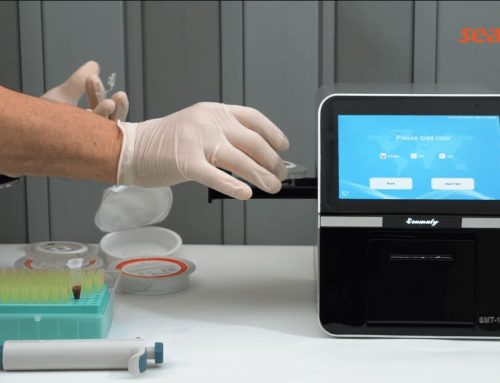Point-of-care (POC) arterial blood gas (ABG) analysis is a cornerstone of modern clinical practice, enabling healthcare providers to diagnose, monitor, and treat patients with respiratory, metabolic, or critical care needs. By assessing gas exchange (oxygen and carbon dioxide) and acid-base balance in the bloodstream, ABG testing delivers actionable insights for managing life-threatening conditions like respiratory failure, septic shock, and diabetic ketoacidosis. To maximize the value of ABG analysis, selecting a reliable, efficient device is critical—and the Seamaty SG1 Blood Gas & Electrolyte Analyzer stands out as a portable, user-friendly solution designed for real-world clinical demands.
1. Blood Sampling for ABG Analysis: Techniques & Best Practices
Accurate ABG results begin with proper blood collection. Two primary methods are used: arterial blood gas (ABG) sampling and venous blood gas (VBG) sampling—both of which require strict adherence to aseptic technique and protocol. The Seamaty SG1 is engineered to support both sample types, aligning with diverse clinical needs.
1.1 ABG Sampling
- Site Selection: The radial artery is the most common site, as it is easily accessible and has a low risk of complications. Before puncture, perform the modified Allen’s test to confirm adequate collateral circulation (preventing ischemia if the radial artery is compromised).
- Collection Method: Insert a needle at the point of strongest radial pulse; arterial pressure will passively fill the syringe.
- SG1 Compatibility: The SG1 accepts arterial whole blood (per its specifications: Sample Type: Arterial or venous whole blood), ensuring seamless integration with standard ABG sampling workflows.
1.2 VBG Sampling
- Site Selection: Venous samples can be drawn from central (e.g., central venous catheters) or peripheral veins.
- Collection Method: Venous pressure is lower than arterial pressure, so manual aspiration into the syringe may be required to obtain sufficient volume.
- SG1 Advantage: With a minimal sample volume requirement of just 100μL (Sample Volume: 100ul), the SG1 reduces the need for large venous draws—minimizing patient discomfort and sample waste.
1.3 Universal Sampling Precautions
- Asepsis: Use sterile equipment and clean the puncture site to prevent infection.
- Anticoagulation: Collect blood in a heparinized syringe to avoid clotting (critical for accurate electrolyte and gas measurements).
- Sample Handling: Remove air bubbles (they falsely elevate pO2 readings), label the syringe with patient ID and inspired oxygen (FiO2) levels, and analyze promptly. The SG1’s 4-minute result time (Fast results: Accurate results in 4 minutes, sample testing in 50 seconds) eliminates delays, addressing the International Federation of Clinical Chemistry’s (IFCC) recommendation to analyze pO2/pCO2 samples within 15 minutes.
2. Indications for ABG Analysis
ABG testing is essential for evaluating patients with conditions that disrupt gas exchange, acid-base balance, or circulatory function. The Seamaty SG1’s multi-parameter test cards (a key product feature) are designed to cover all core indications by measuring 19+ parameters, including:
| Clinical Indication | Key Parameters Measured by SG1 |
|---|---|
| Respiratory status (e.g., asthma, COPD) | pO2, pCO2, cSO2, cHgb |
| Acid-base disorders (e.g., diabetic ketoacidosis, uremia) | pH, HCO3-, BE(ecf), BE(B), AGap, cTCO2 |
| Critical care monitoring (e.g., sepsis, post-surgery) | Lactate (Lac), BUN, Creatinine (Crea), electrolytes (K+, Na+, Cl-, Ca2+) |
| Circulatory adequacy | Hct, cHgb, central venous oxygen saturation (via derived parameters) |
By combining these parameters on a single, disposable test card (Single-use test card with unique biosensor combinations), the SG1 eliminates the need for multiple devices—saving time and reducing operational complexity.
3. Contraindications to ABG Analysis
ABG testing is invalid if:
- The ABG machine is malfunctioning or uncalibrated.
- Samples are improperly handled (e.g., air bubbles, prolonged storage, inadequate labeling).
- Specimens are clotted or insufficiently anticoagulated.
The Seamaty SG1 mitigates these risks with real-time quality control (QC) (QC & Calibrate: Real time QC). Before each test, the SG1 automatically verifies electrode performance and sample integrity, alerting users to issues like clots or uncalibrated sensors—ensuring only valid results are reported.
4. Hazards & Complications of ABG Testing
While ABG sampling is generally safe, potential risks include:
- Local complications: Pain, hematoma, hemorrhage, or vessel trauma.
- Infection: From blood-borne pathogens (e.g., HIV, hepatitis) if safety protocols are violated.
- Cross-contamination: Between samples if equipment is not properly cleaned.
The SG1 addresses these concerns through:
- Single-use test cards: Eliminate cross-contamination by ensuring no shared components between samples.
- Portable design: Reduces the need to transport patients to a lab, minimizing movement-related trauma (e.g., hematoma from jarring).
- Sterile workflow integration: The device’s 3-step operation (Add sample → Insert cartridge → Read result) simplifies aseptic handling, lowering infection risk.
5. Understanding ABG Test Parameters
ABG analyzers measure direct parameters (via electrodes) and calculate derived parameters (using mathematical formulas). The Seamaty SG1’s advanced biosensor technology ensures accuracy for both categories:
5.1 Directly Measured Parameters
- Acid-base balance: pH (via Sanz electrode).
- Gas exchange: pCO2 (Severinghaus electrode), pO2 (Clark electrode).
- Electrolytes: K+, Na+, Cl-, Ca2+ (ion-selective electrodes).
- Metabolites: Glucose (Glu), Lactate (Lac), Creatinine (Crea), BUN (immobilized enzyme sensors).
- Hemoglobin markers: cHgb (total hemoglobin), cSO2 (oxyhemoglobin saturation), FCOHb (carboxyhemoglobin), FMetHb (methemoglobin) (via co-oximetry).
5.2 Derived Parameters
Calculated from direct measurements to simplify clinical interpretation:
- Bicarbonate (cHCO3-): Uses the Henderson–Hasselbalch equation to assess metabolic acid-base status.
- Base Excess (BE(ecf), BE(B)): Via the Van Slyke equation—indicates excess or deficit of base in blood.
- Anion Gap (AGap): Difference between cations (Na+, K+) and anions (Cl-, HCO3-)—identifies causes of metabolic acidosis.
- cTCO2 (total carbon dioxide): Combines dissolved CO2 and bicarbonate for comprehensive metabolic assessment.
6. Preanalytical Problems: How the SG1 Reduces Errors
Preanalytical errors (e.g., delayed analysis, temperature fluctuations) are the leading cause of inaccurate ABG results. The SG1 is designed to address these challenges head-on:
| Preanalytical Issue | SG1 Solution |
|---|---|
| Time sensitivity | 4-minute total result time (50 seconds for sample testing) ensures compliance with IFCC’s 15-minute window. |
| Temperature effects | Operating temperature range of 5–32°C (Operating Temperature: 5 – 32 °C) stabilizes performance in clinical settings (e.g., emergency rooms, field clinics). |
| Syringe compatibility | Works with standard heparinized syringes and accepts 100μL samples—no specialized equipment needed. |
| Air bubbles | Simple 3-step workflow reduces user error; the test card’s design minimizes bubble entrapment. |
| Mixing errors | The SG1’s test card automatically mixes sample and reagents, eliminating the need for manual agitation. |
7. The Seamaty SG1: A Portable ABG Analyzer for Every Setting
Traditional benchtop ABG analyzers are limited to labs, but the SG1’s handheld portability (Weight: 600g; Built-in 3.7V, 5000mAh battery) enables testing at the patient’s side—whether in an exam room, ambulance, or remote clinic. Key features include:
- User-Friendly Interface: 4.3-inch IPS touch screen (Display: 4.3 IPS touch screen) guides users through testing, reducing training time for staff.
- Built-In Printer: Thermal printer (Printer: Built-in thermal printer) generates instant hard copies of results for medical records.
- Durable Design: Lightweight yet robust, with a Type-C connector (Connectors: Type-c) for easy charging and data transfer.
- Flexible Testing Modes: Supports both human and veterinary testing (per prior customer communications), making it ideal for clinics, hospitals, and animal health facilities.
8. Quality Control & Calibration: Ensuring SG1 Accuracy
Reliable ABG results depend on rigorous quality control (QC) and calibration—areas where the SG1 excels:
8.1 Internal Quality Control (IQC)
- Real-Time QC: The SG1 runs automatic QC checks before each test, using pre-calibrated sensors to verify parameter accuracy.
- QC Data Logging: All QC results are stored on the device, enabling easy auditing and compliance with regulatory standards.
- Commercial Controls: Supports use of 3 levels of external QC materials to establish mean, standard deviation, and acceptable ranges for each parameter.
8.2 External Quality Control (Proficiency Testing)
- The SG1 is compatible with third-party proficiency testing programs (e.g., CAP, EQAS), ensuring results align with global clinical standards.
- For labs replacing old equipment, the SG1 supports duplicate analysis to compare performance with existing devices—ensuring a smooth transition.
8.3 Calibration
- Two-System Calibration: Uses gas reagents for pO2/pCO2 and liquid reagents for electrolytes/metabolites—covering all measured parameters.
- Calibration Verification: Required before initial use and every 6 months (per clinical best practices), using 3 levels of control material to validate the analyzer’s measuring range.
- Simplified Process: Seamaty provides pre-mixed calibration reagents and step-by-step guides, reducing downtime.
9. Limitations of ABG Analysis & SG1 Mitigations
While ABG testing is powerful, it has limitations—many of which the SG1 addresses:
- Hemolysis: Can cause pseudohyperkalemia (falsely elevated K+). The SG1’s real-time QC alerts users to hemolyzed samples, preventing incorrect reporting.
- Temperature Correction: Debate exists about when to correct results for patient temperature. The SG1 reports both measured (37°C) and temperature-corrected values (on request), giving clinicians flexibility.
- Hemoglobin Discrepancies: Handheld analyzers sometimes calculate Hgb from Hct— but the SG1 uses direct co-oximetry for cHgb, reducing errors from plasma composition changes.
- Membrane Interference: Substances like methylene blue or hyperlipidemia can skew results. The SG1’s specialized biosensors (unique combination of biosensors) minimize such interference.
10. Conclusion: Elevate ABG Testing with Seamaty SG1
Arterial blood gas analysis is indispensable for critical care, but its value depends on the right device. The Seamaty SG1 combines portability, speed, and accuracy—delivering lab-quality results in 4 minutes, at the patient’s side, with minimal training. Whether you’re managing emergency cases, monitoring chronic conditions, or serving remote communities, the SG1 is engineered to meet your clinical needs.
For inquiries about rotor models (test cards) or customized solutions, contact our support team at [your email/phone]—we’re here to help you optimize your ABG workflow.




Leave A Comment